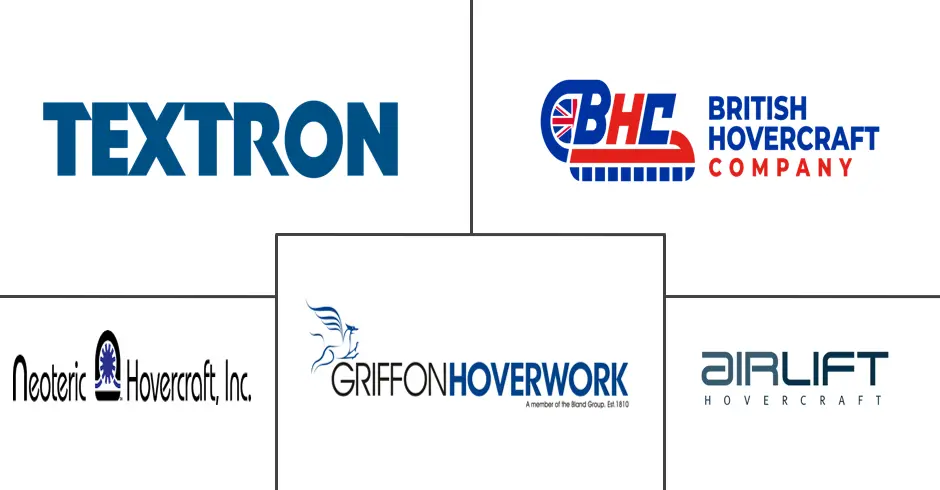Hovercraft Market Size and Share
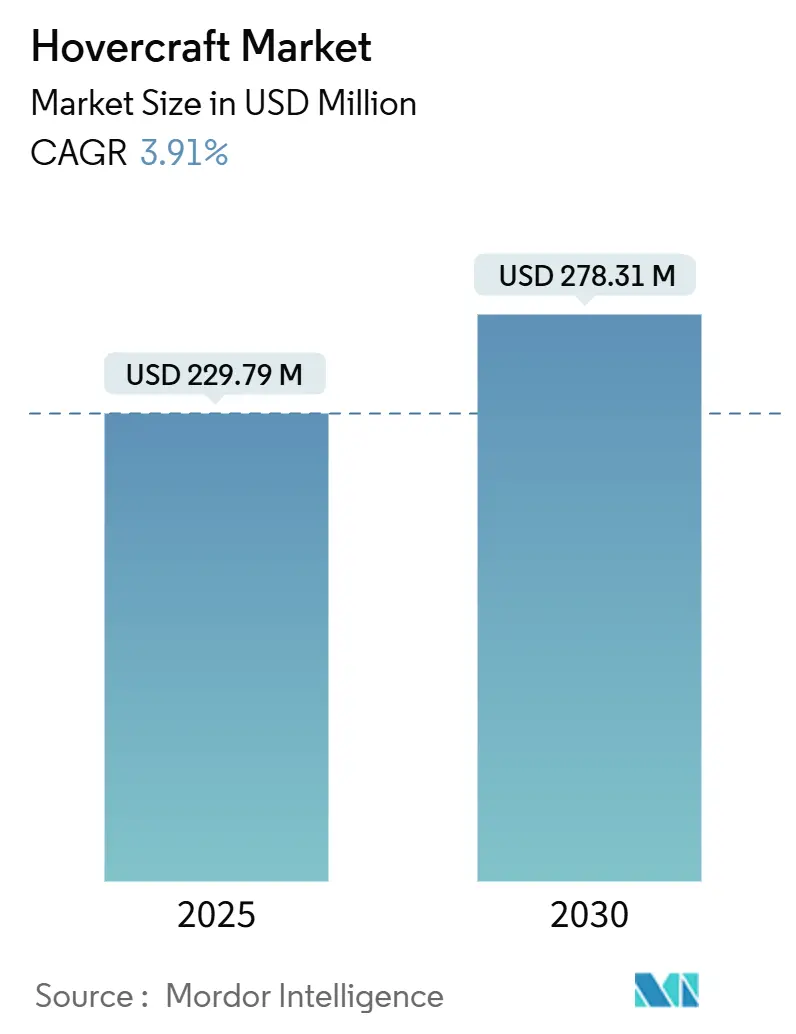
Hovercraft Market Analysis by Mordor Intelligence
The hovercraft market size stood at USD 229.79 million in 2025 and is forecasted to advance to USD 278.31 million by 2030, registering a 3.91% CAGR. Demand is shifting from predominantly military fleets toward commercial uses as coastal flooding, offshore energy expansion, and disaster-response planning make air-cushion vehicles part of critical transport infrastructure. Military fleet replacement programs contribute steady baseline spending, while environmental regulations and noise limits accelerate investment in electric and hybrid propulsion. Manufacturers that can certify low-noise craft and prove multi-mission flexibility are capturing new contracts, especially where ground transport is unreliable or sea-state conditions are harsh. Partnerships between technology providers and energy operators also broaden the customer base, supporting sustained growth in the hovercraft market.
Key Report Takeaways
- By craft size, medium hovercraft commanded 45.11% of the market size in 2024; small craft are advancing at a 4.82% CAGR over the forecast period.
- By application, defense and security accounted for 35.45% of the hovercraft market share in 2024, while offshore energy support is forecasted to grow at a 5.12% CAGR to 2030.
- By propulsion type, diesel engines held 52.70% share of the hovercraft market size in 2024; fully electric systems are rising at an 8.90% CAGR during 2025-2030.
- By end user, the military segment led with 60.21% revenue share in 2024; the commercial segment is projected to expand at a 4.75% CAGR through 2030.
- By geography, Asia-Pacific captured 32.40% of revenue in 2024, whereas the Middle East and Africa market is expected to record the fastest 5.75% CAGR to 2030.
Global Hovercraft Market Trends and Insights
Drivers Impact Analysis
| Driver | (~) % Impact on CAGR Forecast | Geographic Relevance | Impact Timeline |
|---|---|---|---|
| Rising demand for amphibious transport amid climate-driven floods | +0.8% | Flood-prone coastal regions worldwide | Medium term (2-4 years) |
| Military fleet replacement cycles for modern assault craft | +1.2% | North America, Europe, Asia-Pacific | Long term (≥ 4 years) |
| Advances in low-noise electric and hydrogen propulsion | +0.6% | Europe, North America, selected APAC markets | Medium term (2-4 years) |
| Relaxed regulations supporting commercial passenger services | +0.4% | Europe, North America | Short term (≤ 2 years) |
| Offshore energy and polar logistics requirements | +0.7% | Arctic zones and global offshore energy corridors | Long term (≥ 4 years) |
| Increased investment in flood-oriented emergency response | +0.5% | Climate-vulnerable regions worldwide | Medium term (2-4 years) |
| Source: Mordor Intelligence | |||
Rising demand for amphibious transport amid climate-driven floods
Coastal flooding disrupts roads, railways, and runways, prompting agencies to procure vehicles that can glide over water, mud, and debris. The Canadian Coast Guard’s USD 5 million order for next-generation air-cushion craft is emblematic of how governments now treat hovercraft as core resilience assets rather than niche tools.[1]Canadian Coast Guard, “Government of Canada awards design contract for new Air Cushion Vehicles,” ccg-gcc.gc.ca Municipal authorities in Southeast Asia and the United States Gulf Coast are conducting pilot programs that measure response-time savings during storms. Insurance firms increasingly recognize the value of rapid evacuation capability, which shortens claim settlements and reduces business-interruption losses. These factors collectively strengthen the long-term foundation of the hovercraft market.
Military fleet replacement cycles for modern assault craft
Legacy landing craft built in the 1980s are nearing the end of their service life, and defense ministries are funding successors with higher payloads, lower signatures, and autonomous options. The US Navy’s Ship-to-Shore Connector program illustrates this push with multi-year contracts exceeding USD 600 million as of late 2024. Similar procurement lines exist in Japan, the UK, and China, emphasizing common hull modules that can accept future sensor or weapons upgrades. Long acquisition horizons translate into predictable revenue streams for incumbent manufacturers, reinforcing the central role of military budgets in the hovercraft market.
Advances in low-noise electric and hydrogen propulsion
Electric drive eliminates gearbox whine and reduces propeller tip noise, opening routes near residential shorelines where diesel craft face curfews. Norway’s TECO 2030 project targets a 35-knot, 160-nautical-mile zero-emission demonstrator that combines surface-effect hulls with fuel cells. Tier-1 suppliers now offer modular battery trays that can retrofit older hulls, accelerating adoption in survey and tourism fleets. Technology diffusion is further aided by subsidies that offset battery costs and port authorities granting preferential berth fees to low-emission vessels.
Offshore energy and polar logistics requirements
Wind, gas, and mineral projects in shallow or ice-prone waters demand transport independent of port infrastructure. Griffon Hoverwork and Crowley have demonstrated year-round supply runs in Alaska, confirming lower weather-related downtime than conventional landing craft. Oil majors now include hovercraft corridors in field-development scenarios, underpinned by lower life-cycle costs than seasonal icebreakers.
Restraints Impact Analysis
| Restraint | (~) % Impact on CAGR Forecast | Geographic Relevance | Impact Timeline |
|---|---|---|---|
| High operating noise and coastal environmental restrictions | -0.9% | Developed markets with strict coastal regulations | Short term (≤ 2 years) |
| Scarcity of certified pilots and maintenance technicians | -0.6% | Global, especially in emerging commercial fleets | Medium term (2-4 years) |
| Competition from ground-effect and hydrofoil vessels | -0.4% | Passenger transport corridors | Medium term (2-4 years) |
| Fuel-cost volatility affecting military procurement cycles | -0.3% | Worldwide defense procurement | Short term (≤ 2 years) |
| Source: Mordor Intelligence | |||
High operating noise and environmental limits
Propeller tip vortices generate tonal peaks propagating over flat water surfaces, often exceeding 90 dB at 200 m. The UK statutes, dating back to the Hovercraft Act of 1968, still influence license terms, requiring operators to curtail schedules during evening hours. Coastal communities in France and California have blocked proposed routes until acoustic modeling proves compliance. Manufacturers now invest in variable-pitch fans and shrouded intakes, yet engineering trade-offs remain between noise, thrust, and range.
Shortage of certified pilots and technicians
Hovercraft crews must master aerodynamic lift control and marine collision regulations, a dual skill set few maritime academies teach. Most training centers are attached to military bases, limiting civil intake. The US Navy’s separate USD 39.3 million outlay for full-motion simulators underscores how costly it is to scale training infrastructure. Until more civilian programs obtain accreditation, crew scarcity will curb fleet expansion, particularly among small private operators.
Segment Analysis
By Hovercraft Size: Medium Craft Dominance Faces Small Segment Growth
Medium craft between 20 m and 30 m length made up 45.11% of 2024 revenue, largely because their 30–70 t payloads satisfy the broadest range of missions from troop lift to ambulance duty. However, small craft under 12 m length show the liveliest 4.82% CAGR as coastal patrol units and scientific agencies prioritize agility over capacity. Lower crew requirements and simplified licensing in many jurisdictions also support the hovercraft market size for small platforms.
Manufacturers promote modular decks that accept survey sonar, agricultural sprayers, or stretchers, tailoring one hull to multiple niches. This customization trend and the spread of autonomy packages that offset limited crew availability underpin sustained double-digit order growth for the small-craft segment.

Note: Segment shares of all individual segments available upon report purchase
By Application: Defense Security Leads While Offshore Energy Accelerates
Defense and security missions led 2024 revenue with a 35.45% share, spanning amphibious assault, port protection, and mine countermeasures. Governments value fast beach access and the ability to ride over anti-landing obstacles. Conversely, offshore energy support, while smaller, is growing at a 5.12% CAGR that outpaces every other use case. Wind-farm crew transfer, Arctic resupply, and pipeline maintenance outperform passenger travel in investment momentum.
Hovercraft can berth directly on rocky causeways and floating ice, slashing transit times compared to barges requiring deeper drafts. Energy operators embrace this flexibility because it lowers weather-related shutdown days and improves safety. Collectively, these dynamics diversify revenue streams and cushion the market against defense-budget cycles.
By Propulsion System: Electric Revolution Disrupts Diesel Dominance
Diesel engines held 52.70% revenue share in 2024, underscoring entrenched preferences for high power-to-weight ratios. Nevertheless, the 8.90% CAGR for electric and hybrid systems signals a rapid transition. Tourism, surveying, and commuter transport operators implement battery packs to meet shoreline noise ordinances and greenhouse-gas targets. Therefore, the hovercraft market share for diesel power is expected to erode steadily as fuel-cell demonstrators validate longer routes.
Hybrid architectures add starter-generators to conventional engines, offering quiet harbor maneuvering and regenerative braking on deceleration. Such incremental pathways allow fleet managers to cut emissions without sacrificing endurance, accelerating the propulsion shift across new-build and retrofit projects.
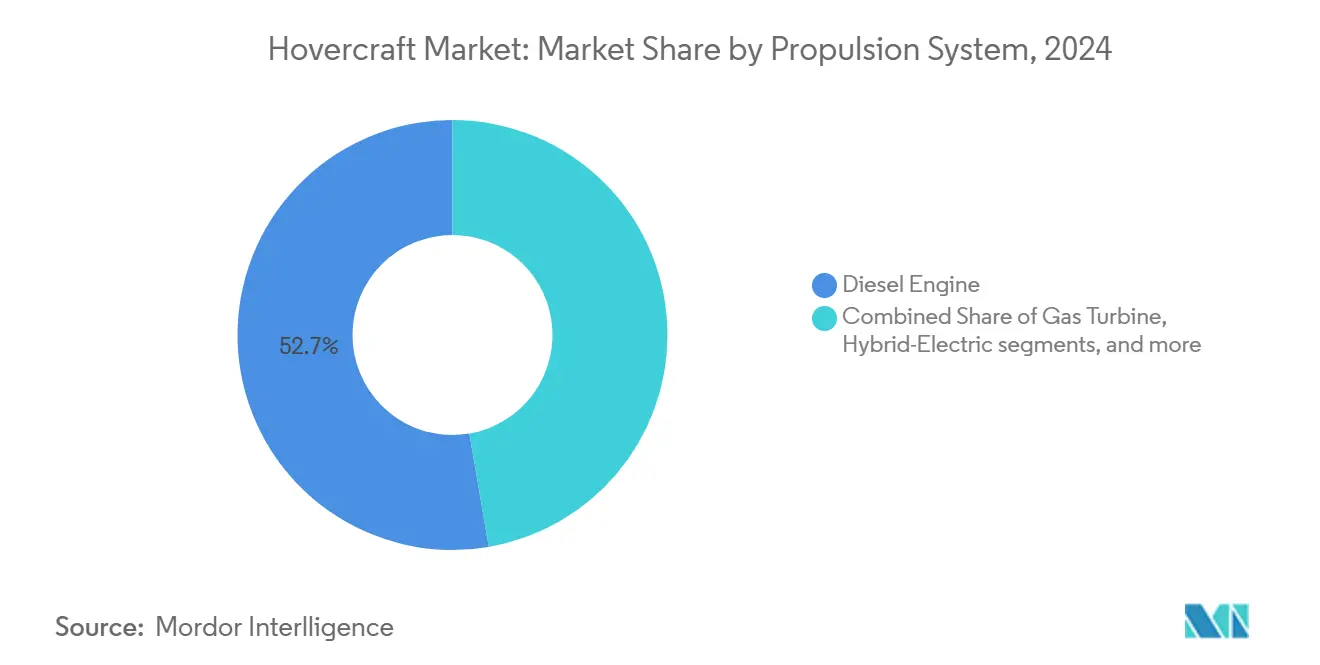
Note: Segment shares of all individual segments available upon report purchase
By End User: Military Dominance Faces Commercial Disruption
The hovercraft market size for military customers was the largest in 2024, with armed forces accounting for 60.21% of global revenue. This share reflects ongoing procurement programs such as the US Ship-to-Shore Connector, Japan’s prospective LCAC replacement, and China’s Type 726 series. Military buyers demand payloads above 60 ton, advanced self-defense suites, and compatibility with amphibious ships, driving higher average selling prices. Commercial operators exhibit the faster 4.75% CAGR through 2030 as ferry lines, survey companies, and emergency-response agencies evaluate lower-capacity but highly versatile designs.
Commercial adoption benefits from the trickle-down of proven military hull forms, which lowers development risk and simplifies class-society certification. Leasing models are emerging to spread capital costs, further widening access. As a result, the hovercraft market is gradually rebalancing, with military volumes expected to remain stable while civilian fleets expand the overall customer count.
Geography Analysis
Asia-Pacific retained 32.40% of global revenue in 2024. Chinese shipyards expand indigenous output of Type 716 and Type 726 assault craft to bolster island-chain logistics, while Japan invests in 12000TD passenger units that will connect remote communities to Honshu.[2]Griffon Hoverwork, “12000TD Hovercraft Contract Secured for Japan,” griffonhoverwork.com South Korea explores hover-ambulance pilots for tidal flats, and India’s National Disaster Response Force studies rapid-deployment craft for delta regions. These programs collectively ensure a stable demand for high-capacity platforms.
The Middle East and Africa region, representing a smaller base, is forecast to grow at 5.75% CAGR through 2030. Abu Dhabi’s pact with Regent Craft to build 12-seat electric seagliders illustrates how investment funds leverage permissive regulations to leapfrog into low-emission transport.[3]Regent Craft, “Abu Dhabi SDF to Manufacture Viceroy Seaglider,” regentcraft.com Saudi Arabia is monitoring the pilot line for potential Red Sea tourism links, while Nigeria evaluates hover-pipeline patrols in the Niger Delta. Climate resilience priorities and ample capital position the region for outsized expansion.
North America and Europe maintain mature yet resilient markets anchored in defense contracts and heritage passenger routes. The United States continues multi-year LCAC procurement, and Canada allocates a budget for Arctic rescue craft that operate on ice pans. Hovertravel celebrates six decades of cross-Solent service in Europe, but route expansions face stringent decibel caps and environmental impact assessments. Scandinavia, however, sees a niche for hydrogen-powered craft on fjord commuter lines, reflecting progressive emissions goals. South America remains nascent due to budget constraints, yet environmental NGOs in the Amazon explore hovercraft for anti-poaching patrols where road networks are sparse.
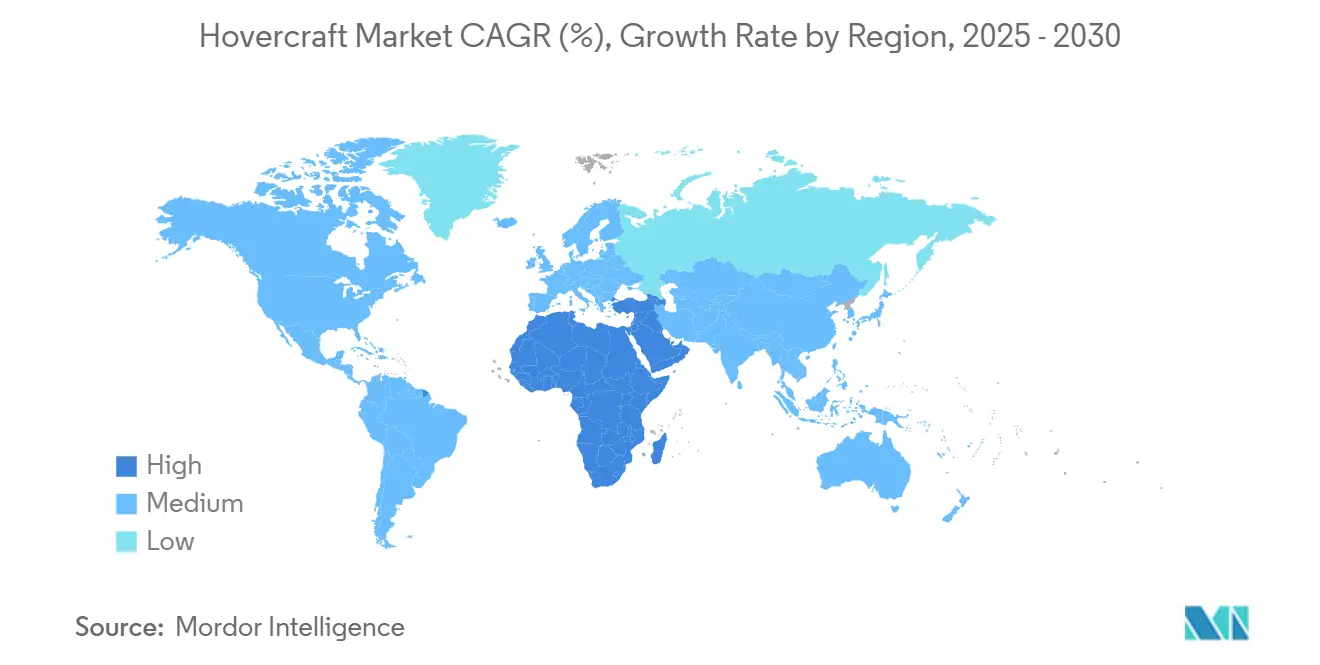
Competitive Landscape
The hovercraft market is moderately consolidated. Five established suppliers—Textron Systems, Griffon Hoverwork, Neoteric, U-Motor, and Christy—account for an estimated 65% of revenue, chiefly through exclusive military and government contracts. Their edge stems from proprietary skirt geometries, in-house composite tooling, and certification track records that shorten customer approval cycles. Newcomers confront high capital barriers yet find openings in sub-10 m electric craft, where tooling costs are lower and regulatory pathways less onerous.
Strategic activity centers on dual-use designs. Textron’s TSUNAMI family draws on autonomous command software proven in unmanned surface vehicles and repackages it for survey and patrol roles, widening the addressable customer set. Griffon integrates battery-electric drivetrains co-developed with maritime fuel-cell specialists to meet European port rules, positioning its offerings ahead of noise and emissions curves. Partnerships between hull builders and sensor integrators grow more common as end users demand turnkey intelligence, surveillance, and reconnaissance capability.
Competitive differentiation increasingly pivots on after-sales services such as simulator-based crew training, predictive-maintenance analytics, and rapid spares logistics. Contractors willing to guarantee availability ratios win favor with energy companies that cannot tolerate downtime. Conversely, military buyers still prioritize ruggedness and global sustainment networks, where incumbents maintain clear advantages. Nevertheless, the rise of electric propulsion and autonomy levels the playing field, allowing agile newcomers to introduce disruptive concepts without inheriting decades of diesel-centric legacy designs.
Hovercraft Industry Leaders
-
Textron Systems Corporation (Textron Inc.)
-
Neoteric Hovercraft Inc.
-
The British Hovercraft Company Ltd.
-
Griffon Hoverwork Ltd.
-
Airlift Hovercraft Pty Ltd.
- *Disclaimer: Major Players sorted in no particular order
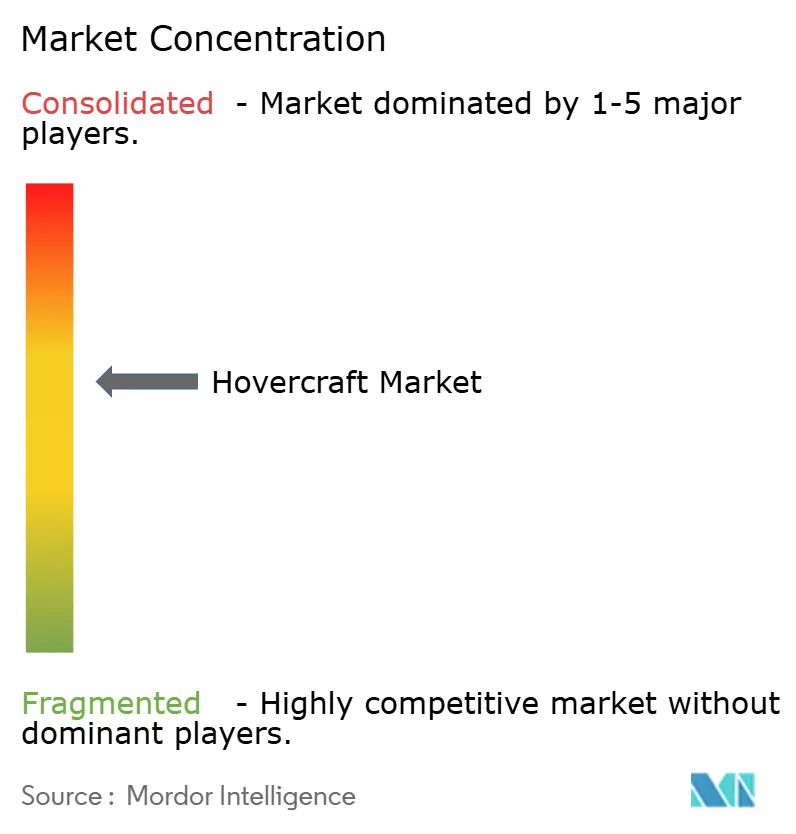


Recent Industry Developments
- March 2025: The US Navy received its 13th Ship to Shore Connector, LCAC 112, from Textron Systems Corporation (Textron Inc.), after successful acceptance trials. This SSC program unit replaces existing LCACs while incorporating modern materials, propulsion, and onboard systems.
- August 2023: The US Navy awarded Textron Systems Corporation (Textron Inc.) a USD 394.2-million contract to construct nine LCAC 100 vessels, following previous orders in 2023 and 2024. Construction completion is scheduled for September 2030.
Research Methodology Framework and Report Scope
Market Definitions and Key Coverage
Our study defines the hovercraft market as revenue generated from newly manufactured air-cushion vehicles that ride on a continuous sheet of pressurized air and can transition seamlessly between water, ice, swamp, and solid ground. These platforms are counted at the point of original sale, including craft purpose-built for military lift, civilian transport, offshore energy support, disaster response, and leisure operations.
Vehicles that achieve lift through wing-in-ground effect, personal hoverboards, and refurbished or second-hand craft are outside this scope.
Segmentation Overview
- By Hovercraft Size
- Small
- Medium
- Large
- By Application
- Defense and Security
- Passenger Ferry Services
- Offshore Energy Support
- Search and Rescue
- Surveying and Mapping
- Agricultural and Environmental Management
- By Propulsion System
- Diesel Engine
- Gas Turbine
- Hybrid-Electric
- Fully Electric
- Hydrogen Fuel-Cell
- By End User
- Military
- Commercial
- By Geography
- North America
- United States
- Canada
- Mexico
- Europe
- United Kingdom
- France
- Germany
- Italy
- Rest of Europe
- Asia-Pacific
- China
- Japan
- South Korea
- India
- Australia
- Rest of Asia-Pacific
- South America
- Brazil
- Argentina
- Rest of South America
- Middle East and Africa
- Middle East
- Saudi Arabia
- UAE
- Rest of Middle East
- Africa
- South Africa
- Rest of Africa
- Middle East
- North America
Detailed Research Methodology and Data Validation
Primary Research
Mordor analysts interviewed hovercraft builders, naval architects, coast-guard officers, and offshore logistics contractors across North America, Europe, and Asia Pacific. These conversations validated average selling prices, clarified typical fleet retirement ages, and tested our assumptions on payload-driven demand swings following heightened defense budgets.
Desk Research
We began with open government sources such as United States Department of Defense contract releases, Eurostat trade codes for HS-880590, and the United Kingdom Maritime & Coastguard Agency vessel registry, which reveal procurement volumes and route deployments. Trade associations like the International Maritime Rescue Federation and the Society of Naval Architects & Marine Engineers supply data on rescue mission counts and hull material trends. Company 10-Ks, investor decks, and reputable media coverage retrieved through Dow Jones Factiva complemented these inputs. Where supplier revenues were opaque, D&B Hoovers helped us approximate segment sales. The sources cited are illustrative; many additional publications were consulted to corroborate figures and fill gaps.
Market-Sizing & Forecasting
We constructed a top-down model that starts with national defense and commercial transport spending pools, followed by penetration-rate assessments that translate budgets into likely hovercraft procurement. Selective bottom-up checks, supplier revenue roll-ups and sampled ASP × unit deliveries, are then used to fine-tune totals. Key variables include (1) defense capital expenditure by branch, (2) count of passenger ferry routes shorter than 50 km, (3) offshore energy platform additions, (4) reported search-and-rescue incidents, and (5) average unit selling price by craft size. A multivariate regression with ARIMA overlay projects each driver through 2030; expert consensus shapes scenario bounds when data are volatile. Where supplier splits were missing, we prorated sales using historical shipment shares and re-verified figures with regional distributors.
Data Validation & Update Cycle
Outputs pass three analyst reviews that compare modeled revenue with independent vessel launch databases and customs declarations. Anomalies trigger call-backs to industry contacts before sign-off. Reports refresh yearly, and material events such as large naval orders prompt interim updates; a final sense-check is run just before client delivery.
Why Our Hovercraft Baseline Commands Reliability
Published market values differ because firms define craft classes, convert currencies, and refresh data on divergent schedules.
Key Gap Drivers include varied treatment of custom military programs, inclusion or exclusion of commercial passenger refits, and inconsistent inflation adjustments.
Benchmark comparison
| Market Size | Anonymized source | Primary gap driver |
|---|---|---|
| USD 229.79 M (2025) | Mordor Intelligence | - |
| USD 167.6 M (2024) | Global Consultancy A | Wider reliance on historical unit exports; excludes offshore energy support craft |
| USD 282.6 M (2025) | Industry Association B | Counts experimental wing-in-ground effect vessels and applies list prices without regional ASP normalization |
These comparisons show that Mordor's tight scope alignment, blended modeling, and annual refresh cadence yield a balanced, transparent baseline that decision-makers can retrace and replicate with confidence.


Key Questions Answered in the Report
What is the current value of the hovercraft market?
The hovercraft market was valued at USD 229.79 million in 2025 and is projected to reach USD 278.31 million by 2030.
Which end-user segment dominates hovercraft demand?
Military customers held 60.21% share in 2024, although commercial operators are expanding faster at 4.75% CAGR through 2030.
How fast are electric hovercraft systems growing?
Fully electric and hybrid propulsion systems are advancing at an 8.90% CAGR, the highest rate among all power categories.
Which region is expected to grow the quickest?
The Middle East and Africa hovercraft market is forecast to post a 5.75% CAGR between 2025 and 2030, driven by electric sea glider projects and infrastructure investment.
Why are hovercraft attractive to offshore energy firms?
They can operate year-round in shallow or ice-affected waters, reducing weather downtime and enabling direct beach or platform access without docks.
What are the main barriers to wider hovercraft adoption?
Noise-control regulations, limited pilot-training capacity, and competition from ground-effect or hydrofoil vessels presently constrain rapid expansion, especially in densely populated coastal corridors.
Page last updated on:
